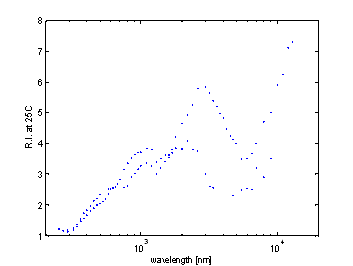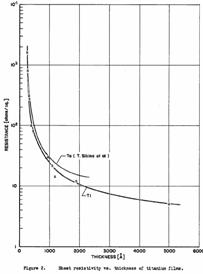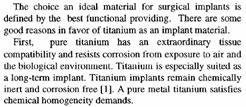6.777J/2.751J Material Property
Database
Material:
Titanium (PVD)
Application: Titanium has good adhesion to silicon and silicon dioxide and is frequently used
as an
adhesion layer for less adhesive metals such as gold
Deposition: Ti is usually
sputtered, using either standard magnetron sputtering, collimated sputtering or
ionized sputtering for good converage in contact of
via bottoms
|
Property |
Value |
Reference |
||||
|
Mass density |
4510 kg/m^3 |
CRC
Materials Science and Engineering Handbook, p.46 |
||||
|
www.matweb.com |
||||||
|
4.54 g/cm3 |
Handbook
of Chemical Vapor Deposition - Principles, Technology and Applications (2nd
Edition) ©1999 |
|||||
|
Young's modulus |
102.6 GPa |
Thin Solid Films,270(1995), p.263. Single layer deposited by DC
planar magnetron sputtering on to 2 inch oxidized Si<111>wafers
at ambient temp., using Ar as sputtering gas,Ar press=2 mT,for film
thickness from 0.1-2.0 um. |
||||
|
169.9 GPa |
Plummer, Table 11-4, page 697 |
|||||
|
123±21 GPa |
C O'Mahony,
M Hill, P J Hughes and |
|||||
|
www.matweb.com |
||||||
|
Poisson ratio |
0.34 |
www.matweb.com |
||||
|
0.32 |
http://www.rti-intl.com/tag/tiroom.htm |
|||||
|
Stiffness constants |
transformation at 800°C |
|
||||
|
Tensile or fracture strength Strain,limiting |
0.004 |
Thin film,used in semiconductor fabrication. IEEE,Micro Electro Mechanical Systems Workshop,Feb
1990, |
||||
|
Hardness |
81-143 kg mm-2 70 kg mm-2 |
Plummer, Table 11-4, page 697 |
||||
|
Residual stress on silicon |
439±41 MPa |
C O'Mahony,
M Hill, P J Hughes and |
||||
|
Specific heat |
522.5 J/kg/K at T=25 C. |
CRC Materials Science and
Engineering Handbook, p.261 |
||||
|
www.matweb.com |
||||||
|
|
Gremlin database (GM0303SF:Substances:Q08
hit 2, GRN 80946)
340051;LitLink; Vol. Ti: MVol.; Pages 156 - 160. 340075;LitLink; Jaeger, F. M.; Rosenbohm,
E.; Fonteyne, R.; PKNAAU; Proc. K. Ned. Akad. Wet.; Vol. 39; ( 1936 )
445 - 453. 340076;LitLink; Jaeger, F. M.; Rosenbohm,
E.; Fonteyne, R.; Rec. Trav.
chim.; Vol. 55; ( 1936 ) 618 - 625. |
|||||
|
Thermal conductivity |
||||||
|
21.9 W/m•K
at T=25 C |
Handbook
of Chemical Vapor Deposition - Principles, Technology and Applications (2nd
Edition) |
|||||
|
21.9 W/m/K at T=300 K. |
CRC Materials Science and
Engineering Handbook, p.274-276 |
|||||
|
Thermal
expansion coefficient: from |
9.5 ppm/K
in the0-300C range |
Bonding properties of metals anodically bonded to glass, Sensors and Actuators A:
Physical, In Press, Corrected Proof,
Available online |
||||
|
Thermal expansion coefficient |
8.41 x 10-6 C-1 |
Plummer, Table 11-4, page 697 |
||||
|
Melting Point |
1650 - 1670 °C 1660 °C |
Plummer, Table 11-4, page 697 Plummer, Table 11-2, page 688 |
||||
|
Dielectric constant |
Not found |
|
||||
|
Index of refraction (at 25C) |
|
Matlab plot made with 100
points from the paper: (Gremlin database) Antonov, V. N.; Kirillova,
M. M.; Krasovskiy, Ye. Ye.; Kurmayeva, L. D.; Minulina, N.
V.; FMMTAK; Fiz. Met. Metallov.; Vol. 69; ( 1990
) 83 - 88; Russian; PHMMA6; Phys. Met. Metallogr.
(Engl. Transl.);
Vol. 69/6; ( 1990 ) 78 - 83 |
||||
|
Electrical conductivity/resistivity |
|
Thin Films of
Titanium and Titanium Oxide for Microminiaturization |
||||
|
40-70 mW cm |
Plummer, Table 11-2, page 688 |
|||||
|
www.matweb.com |
||||||
|
43 mW cm |
Handbook
of Chemical Vapor Deposition - Principles, Technology and Applications (2nd
Edition) ©1999 |
|||||
|
~50mWcm Ohmic contact, stable up to 400C/30min |
Yale Stmusser , “CHARACTERIZATION IN SILICON
PROCESSING”, BUTTERWORTH-HEINEMANN |
|||||
|
Magnetic permeability |
1.00005 |
http://www.rti-intl.com/tag/tiroom.htm |
||||
|
Magnetic Susceptibility |
3.17 x 10-6 cm3/g |
http://www.rti-intl.com/tag/tiroom.htm |
||||
|
Piezoresistivity |
Not found |
|
||||
|
Piezoelectricity |
Not found |
|
||||
|
Wet etching method (these rates apply to sputtered
Ti under the conditions in |
Titanium wet etch: 20 H2O : 1
H2O2 :1 HF wet sink @ ~20C, etch rate: 1100 nm/min. |
|
||||
|
Isotropic silicon etchant
(126 HNO3 : 60 H2O : 5 NH4F), etch rate: 300nm/min. 10:1 HF (10 H2O: 1 49%HF) @ ~20C, etch rate: 1100
nm/min. 5:1 BHF @ RT: etch rate (fast) > 1000nm/min. Piranha |
|
|||||
|
Plasma etching method |
Ion milling KOH: makes the Ti layer "soft" (no
quantitative data) XeFe2 at 2.6mtorr in
homemade chamber, etch rate: 29nm/min (very selective over Al). |
|
||||
|
chlorine,
boron trichloride, nitrogen, etch rate:
0.7 µm/min. selectivity: photoresist-> 1:2, silicon dioxide-> 1:6, |
http://www.mems-
exchange.org/catalog/P2131/ |
|||||
|
Adhesion to silicon dioxide |
Good adhesion to silicon and to silicon dioxide |
Plummer |
||||
|
Biocompatibility |
|
The processing of
surgical implants from pure titanium |
||||
|
“For medical implants, titanium
is considered one of the most biocompatible materials available, especially
where direct contact to tissue or bone is required (i.e. endosseuos
dental implants or porous uncemented orthopedic
implants). See the individual titanium alloy datasheets for specific
applications.” |
www.matweb.com |
|||||
|
“Titanium
and titanium alloy implants are widely used in medicine for their
biocompatibility, good mechanical properties
and excellent corrosion resistance” |
C Madore
and D Landolt, “Electrochemical micromachining of controlled topographies on
titanium for biological applications”, J. Micromech. Microeng. 7 (1997)
270–275. Printed in the |
|||||
|
Hydrophobicity |
Surface contact angle: 54±5o – (moderately wettable / hydrophilic surface) |
Relationship
between surface properties (roughness, wettability)
of titanium and titanium alloys and cell behaviour |
||||
|
Vapor Pressure |
|
Gremlin database (GRN 16313) 340051;LitLink; Vol. Ti: MVol.; Pages 156 - 160. 340059;LitLink; Blocher, J. M.;
Campbell, I. E.; JACSAT; J. Am. Chem. Soc.; Vol. 71; ( 1949 ) 4040 - 4042. |
||||
|
Critical
Superconducting Temperature |
0.36 - 0.44 K |
www.matweb.com |
||||




